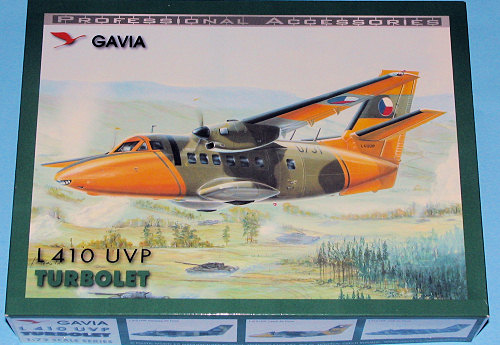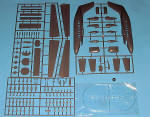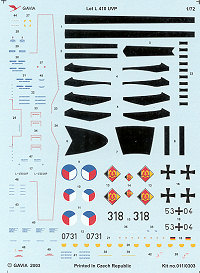
| KIT: | Gavia 1/72 Let L 410 UVP Turbolet |
| KIT #: | 0603 |
| PRICE: | $27.95 from GreatModels |
| DECALS: | Three options |
| REVIEWER: | Scott Van Aken |
| NOTES: | Has bits for the UVP-E |

| HISTORY |
The development of the L-410 started in the sixties in Let Kunovice in Kunovice, Czech Republic. It was designed for the Soviet airline "Aeroflot" who were looking for a turbine-powered replacement for the Antonov An-2 aircraft. After preliminary studies of an aircraft called the L-400, a new version was introduced called the L 410 Turbolet. The first prototype marked XL-410 flew on April 16, 1969. Because of delays in the development of a Czech engine (Walter M 601), the prototype and first production version were powered by P&W PT6-A27 engines.
After M601 development was ended, the PT-6 engine was replaced by the Walter M 601 engines and Avia V508 three-blade propellers and the next variant was introduced, the L 410M.
A further version for Aeroflot was the L 410 UVP. This has improved performance in take-off and landing due to increased wing and tail area, but, because of increased empty weight and the shift of the centre of gravity, decreased seating capacity of 15 passengers.
The L 410 UVP-E (the most common variant of the L 410) has increased maximum take-off weight to 6400 kg, M 601E engines with increased power, new five-blade propellers marked V 510 and the wing can be equipped with tip tanks to increase fuel quantity. First flight was made in 1984, and production started in 1986.
The L-410 UVP-E9 and UVP-E20 are subversions which vary from each other only by minor changes arising from various certification regulations.The last L 410 family member is L 420 using the new engine variant M 601F.
The L 410 UVP-E aircraft is an unpressurized all-metal high-wing commuter airplane, powered by 2 reverse-flow Walter M601 turboprop engines (2x560 kW take-off power) and Avia V 510 five-blade propellers. It is equipped with a retractable undercarriage. The aircraft uses two hydraulic circuits: main and emergency. The main electrical system operates with 28V DC. The de-icing system is leading edge pneumatic deicers and electrical heating of propellers, cockpit wind shields and pitot/static system heads. Maximum take-off weight of the L 410 UVP-E is 6400 kg with the possibility of an increase to 6600 kg for the E9 and E20 variants, seating capacity 17 to 19. Cruise speed is 170 KIAS, maximum range about 770 nautical miles. The airplane is certified for IFR operation, CAT I ILS approach, and flights in icing conditions.
Of the more than 1,000 units built, roughly 500 remain in service. The majority were delivered to the former Soviet Union, but have been resold, particularly to airlines in Asia, Africa and South America. 40 aircraft are in use throughout Europe for commercial operation or skydiving. There are also an unknown number in Russia and Soviet breakaway states. The aircraft can be used with short or even unpaved runways.
| THE KIT |
 Gavia is part of the Eduard family of kits so it will look quite familiar to those who open the box and see the several sprues of grey plastic and one oval sprue of clear bits. I should mention that all the cabin windows have sunken in 'dimples', making any clear image of what is in the cabin a moot point. Too bad as Gavia has provided a rather large sprue for seats and any of the considerable work you'll put into it will go unappreciated. Gavia also provides a nice nose weight, another sign that it is part of the Eduard empire.
Gavia is part of the Eduard family of kits so it will look quite familiar to those who open the box and see the several sprues of grey plastic and one oval sprue of clear bits. I should mention that all the cabin windows have sunken in 'dimples', making any clear image of what is in the cabin a moot point. Too bad as Gavia has provided a rather large sprue for seats and any of the considerable work you'll put into it will go unappreciated. Gavia also provides a nice nose weight, another sign that it is part of the Eduard empire.
The other two of the three sprues are for the airframe itself. As you'd expect, the parts are very nicely molded with finely engraved panel lines. There are no alignment pins for the parts and the tail plane s are butt joined. Small ejector pin towers appear on the inside of the fuselage, engine nacelles and wings. Removal of some of these may be needed to get the parts to properly fit, but should prove to be no real problem. Wheels are molded in two halves to prevent any problems with mold mis-alignment. The upper surface of three of four of the wing halves have some sort of marring on them. I cannot tell if these are scratches, mold glitches or
s are butt joined. Small ejector pin towers appear on the inside of the fuselage, engine nacelles and wings. Removal of some of these may be needed to get the parts to properly fit, but should prove to be no real problem. Wheels are molded in two halves to prevent any problems with mold mis-alignment. The upper surface of three of four of the wing halves have some sort of marring on them. I cannot tell if these are scratches, mold glitches or just flow lines, but a coat of paint will definitely tell one way or the other. Also included is a nicely done etched metal fret for some minor bits like control wheels, antennas and actuator arms.
just flow lines, but a coat of paint will definitely tell one way or the other. Also included is a nicely done etched metal fret for some minor bits like control wheels, antennas and actuator arms.
The instructions are well done and cover the building of the UVP and UVP-E versions. However, this is somewhat moot as the markings are all listed as being for the three bladed prop/no wing tank UVP variant. The color chart offers generic, Humbrol, Tamiya, Revell and Agama paint information. Markings are for three UVP aircraft. One is the box art plane in camo with large yellow patches from the Czech Air Force. The other two are for similar camouflaged planes (but without the yellow bits) for both the East German and later unified German Air Force. The decal sheet covers all the exhaust and de-icer markings, making painting considerably easier, though those yellow bits will need some care.
| CONCLUSIONS |
This is a neat kit of an airplane that is not well known outside the places it is flown. I found it quite odd that we are shown how to build a version for which no markings are supplied. Not only that, but the kit markings are for the least built variants. Fortunately, the internet is full of Let 410 photos and we could easily do the latter version with the assistance of the spare decal box. This is the kind of kit to which I'm drawn as it is both well molded and an unusual subject.
| REFERENCES |
February 2007
You can find this and other fine kits and accessories atGreatModels If you would like your product reviewed fairly and fairly quickly by asite that has nearly 350,000 visitors a month, please contactme or see other details in the